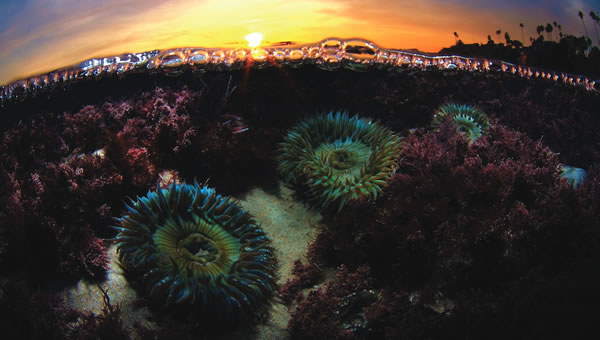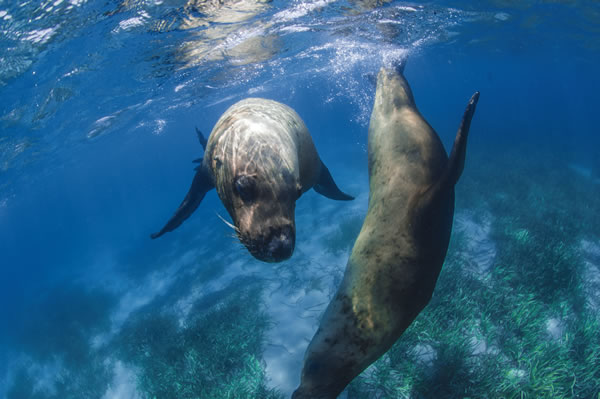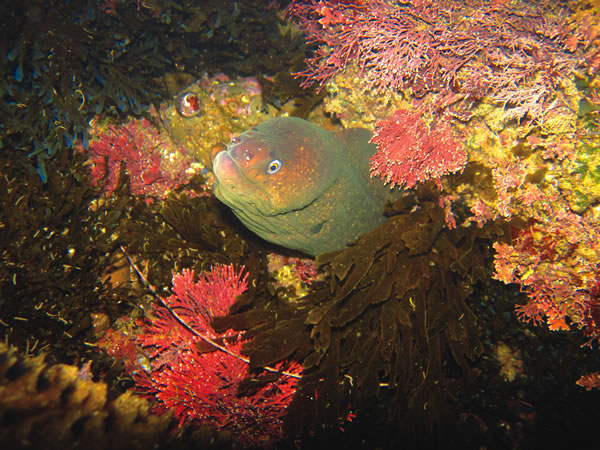Discover a world of life and color beneath the waves.
By Sharael Kolberg

One thing that makes Laguna Beach so extraordinary is the vast ocean views. Residents revel in watching the sunset, playful dolphins, boats sailing by, but the real magic takes place underneath the surface of the ocean. That’s where things come to life.
Beach Cities Scuba instructor Robb Evans, who has been diving off the coast of Laguna Beach for years, has seen a vast variety of marine life here that includes rock fish, bass, opaleye, greenlings, treefish, perch, lobsters, barracuda, sargo, senoritas, gobies, scorpionfish, sheephead, cabezon and several types of rays, starfish, moray eels, octopus and shark.
“You’ll find all of these things and more … beautiful reef structures, giant kelp and shellfish,” Robb says. “It is a complete ecosystem, starting with the algae, krill and other microorganisms as well as nourishment from the sun and plant life living on the reefs.”
Typical dives range from 60 to 130 feet with an average water temperature of about 65 degrees. Not only does Robb enjoy what lurks beneath the surface during the day, but he has also explores the ocean at night. “On a particularly clear evening, a group of us swam through the crevice in the reef at Shaw’s Cove and were treated to hundreds of lobster out looking for food and an octopus working his way across the mussel shells,” he recalls. “As we lit our path through the interior, the huge sponges, anemones and Garibaldi were in plain view. It was as though we were swimming in an aquarium in the dark.” Robb has also seen thornback rays, sheep crab and an occasional shovelnose guitarfish, but one of the most spectacular phenomena at night is bioluminescence (the production and emission of light by organisms such as bacteria and algae). “I turn into a child again when the bioluminescence is active and we turn the lights out and make glitter angels in the darkness.”
Although you won’t find neon-colored tropical fish here, Robb explains that our native species and marine habitats still make the dive well worth the time and effort. “As divers, we travel around the world to marvel at the structures and animals of the sea,” he says. “Colors, shapes and wonder draw us to the underwater world. We interact with nature in its own environment. Our gear costs thousands, travel and accommodations are expensive, and we invest hours and hours into our leisure activity. Yet, right here in Orange County we can see more different animals per square mile than virtually any place in the world.”
Another person who has found the ultimate inspiration through scuba diving here in Orange County is renowned marine life artist Wyland. His gallery in Laguna Beach has artwork that reflects what he has discovered under the sea. “Those firsthand observations of animals in their natural environment brought my understanding to a completely different level,” Wyland says. “Suddenly I was not only painting these magnificent creatures, but the spirit they possess. I started to see all marine life differently. I saw that each of these animals was as unique and different as we are.”

Supporting a Healthy Ocean
Charlotte Masarik and Jinger Wallace of the Laguna Bluebelt Coalition stress the importance of public education in an effort to create and maintain a healthy ocean environment. The coalition brings together organizations and individuals with a common goal of protecting and restoring marine life, conserving biological diversity and maintaining healthy, sustainable marine habitats. “The Laguna Bluebelt encourages people to learn more about where we live in order to understand how to live sustainably and in harmony with the ocean,” Charlotte says.
“Because of our kelp forests, deep ocean canyons, tidepools and the small coves that provide protection for marine life, we have many different kinds of marine life like mollusks, crustaceans, pelagic deep water fish and reef fish,” Jinger says.
One ocean species in the area that has gotten a lot of attention lately, and seems to be making a comeback of sorts, is kelp. “At the core of individual ecosystems is a creature, or in some cases a plant, known as a keystone species. For Laguna, that keystone is our kelp forest,” Charlotte explains. “Instead of roots like a tree that extend into the earth, kelp has ‘anchors’ called holdfasts that grip into our rocky substrate. From the holdfasts, giant kelp can grow toward the water’s surface up to 2 feet a day. Gas bladders called pneumatocysts keep the upper portions of the algae afloat and create the canopy we see from the shore.”
Ginger adds, “There is an interdependence between the kelp and thousands of invertebrates … such as brittle stars, sea stars, anemones, tube snails, sponges and tunicates. Kelp is reliant on a healthy, balanced ecosystem. For example, lobsters and sheephead fish keep the urchin population in check so they do not devour the kelp that provides habitat, food and shelter for thousands of other species. Keeping this balance is one reason why marine reserves are important.”
In January 2012, the coastline of Laguna Beach became a marine protected area, where fishing and taking anything from tidepools is prohibited. These rules were designed to protect marine species and habitat in tidepools and offshore.
Laguna Beach kelp crusader Nancy Caruso has made a significant impact on the restoration of the kelp beds off the coast. She began the 10-year kelp restoration project by having students grow thousands of baby kelp plants in their science classes. Nancy and 250 of her volunteer divers then planted them in the ocean. They also protected the kelp by removing the primary predator, sea urchin; thousands of them were moved far from the kelp beds. Nancy is currently having students raise green abalone and white sea bass to be placed in the restored kelp forests.

Rescuing Marine Mammals
Part of the marine life that relies on kelp are the pinnipeds (fin-footed mammals), such as California sea lions, harbor seals and northern elephant seals. Pinnipeds hunt for shellfish and marine invertebrates that live among the kelp. Tamara Galvan, education coordinator for the Pacific Marine Mammal Center, says sometimes even northern fur seals can be found off of the Orange County coast.
“Seals lions and seals can often be seen on buoys, rock jetties, docks and, of course, in the water,” Tamara points out. “They eat small schooling fish and squid, and are dependent on the health of the kelp forest and the ocean ecosystem.”
Pinnipeds are protected by the Marine Mammal Protection Act. Keeping a safe distance is important for people as well as for the safety and the health of the animals—pinnipeds can bite. “When people approach the animals, it can lead to stress for the animal,” Tamara says. “Stress is harmful for an animal that is already sick.” Harassing any marine mammal can result in a substantial fine.
Migrating Marine Life
Some of the larger marine life that lives in our coastal water includes dolphins and whales. But as Harry Helling, president and CEO of Crystal Cove Alliance puts it, “Like our human populations, some live here all the time, while others just pass on through.” From December to April, gray whales can be seen as they make their 12,000-mile migration from the Bering Sea to Baja California. Harry mentions that it is also possible to see orcas, fin whales, humpbacks, Risso’s dolphins, warm water yellowfin tuna, certain species of jellyfish and the giant Humboldt squid passing through regularly, seasonally or just occasionally due to variations in water temperature or feeding patterns. “When we talk about marine habitat, we always include dozens of bird species too—gulls, sandpipers, plovers, herons—that migrate along what is known as the Pacific Flyway,” Harry says.
An important part of the ecosystem that lives here year-round is the plankton. “The weight of the microscopic life far outweighs all of the larger animals, and it’s important that any discussion about marine ecosystems includes plankton,” Harry says. “Living and growing off Crystal Cove are many of the small filter feeders that depend on the rich plankton including mussels, clams, barnacles and small fish like sardines and grunion.” According to Harry, other microscopic life that can be found includes copepods, larval crabs and barnacles, dinoflagellates and fish eggs that thrive in the water here partly because of the nutrients that occur from either land runoff or upwelling (being brought up from the ocean bottom).
Just as humans live the cycle of life from birth to death with a lot of drama in-between on land, so does life in the sea. So, the next time you’re gazing out at our gorgeous ocean view, stop and contemplate the soap opera that’s taking place beneath the waves. LBM

Scuba Diving in Laguna
Best spots: Robb Evans of Beach Cities Scuba explains, “Shaw’s Cove by nature of its south-facing beach is dive-able almost any time of year because of low surf and almost nonexistent current. Easy beach entries, short distance to the water, concrete steps and safe parking are but a few of the benefits of the site. The reef is structured in such a way that a novice can navigate it with relative ease. Depths to 50 feet allow for beginning or advanced divers to enjoy the site in safety.” Crescent Bay is also known ideal conditions.
When: Dive day or night, but you may see the bioluminescence at night.
What you might see: Rockfish, Garibaldi (the marine state fish of California), bass, opaleyes, greenlings, treefish, perches, lobsters, barracuda, sargo, senoritas, gobies, scorpionfish, sheephead, cabezon, rays, starfish, moray eels, octopus, shark, sea lions, dolphins, whales and kelp.





Thank you Sharael for giving me the chance to be a part of this story! I think you did a fantastic job reflecting how I feel about diving in Laguna Beach. Let me know if I or Beach Cities Scuba can be of any further assistance.